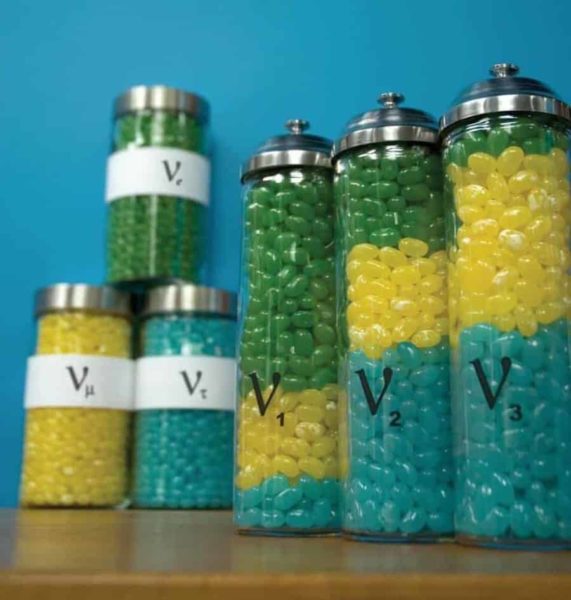Buzzing through space, through our bodies, virtually everywhere, are billions upon billions of neutrinos. Behind only photons as the most abundant fundamental particle in the universe, neutrinos are enjoying a popular heyday. The subject of a recent Nobel Prize and the Breakthrough Prize in Fundamental Physics, neutrinos have hundreds of scientists all over the world, including several at Colorado State University, working to unlock all their mysteries.
Two separate, international scientific collaborations studying neutrinos, the T2K experiment in Japan, and the NOvA experiment at Fermilab, have reported new insights into how neutrinos behave. CSU researchers have played a significant role in both. Both sets of neutrino findings were announced at the International Conference on High Energy Physics in Chicago, Aug. 3-10.
T2K: Opposite, but not equal particles
The T2K scientists, among them CSU physics professors Walter Toki and Robert J. Wilson, have reported a key difference in behavior between neutrinos and their equal, opposite particles, antineutrinos. They found that neutrinos oscillate – that is, switch between three different “flavors” – at different rates than antineutrinos oscillate. (The discovery that neutrinos oscillate at all was the subject of the 2015 Nobel Prize in Physics.)
In particular, the T2K researchers found that the probability of muon-type neutrinos oscillating into electron-type neutrinos is higher than the probability of muon-type antineutrinos oscillating into electron-type antineutrinos.
Why is this significant? These results, Toki explained, violate a longstanding physics principle called charge parity symmetry.
“According to theory, these oscillation rates should have been closer together,” Toki said. “From here, we’re basically going to take even more data to try and increase the number of oscillation events. This will mean higher precision on what appears to be a big difference between neutrinos and antineutrinos.”
Violation of charge parity symmetry could hold the key to “one of the most profound questions in science” – why the universe is composed of matter today, even though the big bang produced equal parts matter and antimatter, according to the T2K collaboration’s news release on the results.
The T2K result does not count as statistically significant yet, the scientists warn. “It is nevertheless an intriguing hint that the neutrino will continue to provide new breakthroughs in our understanding of the universe.”
T2K comprises a proton accelerator called J-PARC on the east coast of Japan, and the Super-Kamiokande detector 180 miles away on the west coast of Japan. The experiment involves shooting a beam of neutrinos from the accelerator to the detector, and scientists observing how the muons change and interact.
“Neutrinos are as interesting as electrons were 150 years ago,” Toki said. “We believe neutrinos are at just a beginning stage of being understood.”
At CSU, T2K researchers include Toki, Wilson, staff scientists Dan Cherdack and Erez Reinherz-Aronis, and graduate students Thomas Campbell, Matt Hogan and Jackie Schwehr. T2K fired its first neutrino beam in 2009.
NOvA: How neutrinos do or don’t ‘mix’
CSU’s Norman Buchanan, associate professor of physics, works on Fermilab’s NOvA experiment, running since 2014. Like T2K, NOvA also looks at how neutrinos oscillate between “flavors” – muon, tau and electron – and also how they exist in three states of mass. Neutrinos are hard to study because they keep changing their identities. What’s more, the flavors don’t necessarily correspond to the three mass states. The way flavors and masses relate in the neutrino world is a process called mixing.
The NOvA scientists now report evidence that one of the three neutrino mass states might not include equal parts of muon and tau flavors, as previously thought. This is called “nonmaximal mixing.” The experiment hasn’t collected enough data yet to claim discovery of nonmaximal mixing, but further exploration will seek to confirm these initial results.
“We want to look more closely at the physics here, because there is something going on that we haven’t yet accessed,” Buchanan said.

From the NOvA experiment result: An illustration of the three neutrino mass states and the three flavors that make them up (electron, muon and tau), as they were previously thought to mix. NOvA’s new result shows that the third mass state may not have equal amounts of muon (yellow jellybeans) and tau (blue jellybeans) flavors. Credit: Fermilab/Sandbox Studios
There are many reasons to be excited about neutrinos, Buchanan said. What’s most intriguing to him is the chance to learn more about the weak nuclear force. Neutrinos are the only matter particles that interact exclusively via this fundamental physical force.
“Electromagnetism is well understood, and the strong force is really just a complicated version of the electromagnetic force,” Buchanan explained. “The weak interaction is the odd one out. It is very bizarre. Because of that, it’s an important probe into the Standard Model of Physics, but also, for looking beyond the Standard Model. Everything that tells us if something bizarre is going to happen – everything bizarre about particle physics – we expect to find it in the weak sector.”
Buchanan’s group at CSU has significant involvement in the analyses of interactions in the NOvA near detector using both the neutrino and anti-neutrino beams. He is also one of the NOvA lead scientists working on non-beam-related physics, such as neutrinos resulting from supernovae, or indications of dark matter.
NOvA scientists will soon begin collecting data on neutrinos and antineutrinos, similar to T2K.
At CSU, Buchanan works on NOvA with postdoctoral researcher Shih-Kai Lin and graduate students Paul Rojas and Matt Judah.
If our reporting has informed or inspired you, please consider making a donation. Every contribution, no matter the size, empowers us to continue delivering accurate, engaging, and trustworthy science and medical news. Independent journalism requires time, effort, and resources—your support ensures we can keep uncovering the stories that matter most to you.
Join us in making knowledge accessible and impactful. Thank you for standing with us!

